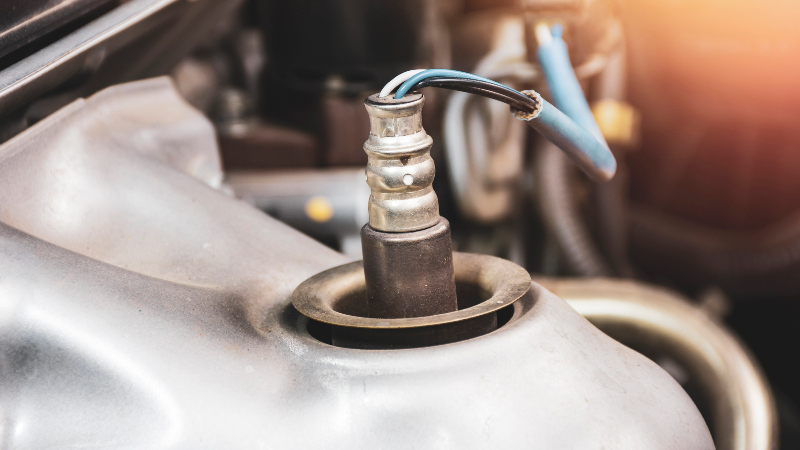Oxygen Sensor Replacement Cost

Internal combustion engines use a variety of sensors and controllers to ensure the fuel-air mixture is correct. One of the key players in this combustion cabal is the oxygen sensor, a.k.a. O2 sensor. Your vehicle likely has more than one, and they all have to be working properly for your vehicle to run right. We suspect you just had a mechanic tell you that you need an O2 sensor, so let’s jump to the end right now. Replacing an oxygen sensor typically costs between $300 and $500.
What is an Oxygen Sensor and What Does It Do?
Your vehicle is like a pump. It pumps air and fuel into the engine, and the mixture undergoes combustion, changing the gasses and creating heat. The gasses that leave the combustion chamber flow into your exhaust manifold and head for the catalytic converter. There, they are changed again into gasses that cause less air pollution in the form of oxides of nitrogen (NOx). Your catalytic converter is a modern miracle with no moving parts made from some pretty expensive and exotic materials.
Here’s where the O2 sensor comes into play. To ensure the engine is being fed with the correct balance of fuel and air, your car watches what is happening after the combustion. The O2 sensors in your car, there are almost always more than one, measure the oxygen to determine if the fuel-air mixture is right. If it needs a tweak, the sensor tells your car’s computer what to do, and the car adjusts its fuel-air mixture on the go. A car can run just right, run rich (too much gas), or run lean (too little).
O2 sensors use an electrochemical fuel cell called the Nernst cell to make the determination. This is an electrochemical device named after one of the fathers of modern thermodynamics. The device compares the oxygen in the ambient air and the exhaust flow to determine a ratio. The computer decides what to do with the information it gets from the sensor. If the sensor stops sending the information, the computer “throws a code” and alerts the driver via the check engine light notification.
Why are the Symptoms of a Bad O2 Sensor?
The first warning sign a driver typically gets about a bad O2 sensor is a check engine light. This light signals that a code has been recorded by the car’s OBD-2 system. The code doesn’t usually say ‘Change downstream O2 sensor,” but it tells your mechanic where to start looking.
In some cases, the car may run poorly, hesitate, or misfire. If your car does any of these things, you should already be driving to the shop anyway. Other failures can cause these symptoms, so a proper diagnosis is required before an O2 sensor can be changed out and the problem solved.
Can I Drive Without an O2 Sensor?
You can drive to the shop with a bad O2 sensor, but any further, and you risk doing far more expensive damage to the car. Catalytic converter damage can result if the warnings of a failing O2 sensor are ignored. If your car’s check engine light is on, have your mechanic diagnose and repair the problem. If your state has an annual emissions inspection, you won’t pass if you are driving around with a bad O2 sensor. The shop will call the SWAT team to surround the building, and you will be hauled off to the gulag. In other cases, the mechanic will say, “You need an O2 sensor.” It depends on your state.
Where Are O2 Sensors and How Are They Replaced?
O2 Sensors are up under your car mounted in the exhaust system. The total number of sensors will be determined by the year of your vehicle, its engine design (I4, I6, V6, V8, etc.), and how many cylinders it has. Replacing O2 sensors is not technically difficult, but it is a challenging repair because the sensors are often difficult to remove. They live their lives in the worst possible conditions and are often corroded in place, for lack of a better description. Getting the old one out without causing damage to your knuckles or the exhaust system is a tricky process.
Your mechanic will first figure out exactly which O2 sensor is the one that is failing. First, she will disconnect the wire from the sensor to the computer. Then, she will remove the old sensor using a wrench or socket (spanner, whichever name you prefer). Next, she will apply some special anti-seize compounds to the threads of the new sensor. The new sensor is installed, and the wire connecting it to the computer is attached. Last, the engine code is cleared, and the car is run for a period of time to ensure the sensor replacement has solved the problem.
Can I Replace My Own O2 Sensor?
It is possible for an experienced DIY-er to do this work if they have special tools, but Car Talk recommends that owners consider using a trusted repair shop for this work. Time is money, and you will not be able to diagnose and replace the sensor anywhere near as fast as the local, independent mechanic. If your car is still under warranty, start at your dealer.
How Much Does an O2 Sensor Replacement Cost?
O2 Sensors themselves are usually priced between $50 and $150. The diagnostic time, labor, and parts can result in a bill of up to around $500 for mainstream cars like a Toyota Camry. If you own a luxury V12 Acme Glutton hand-built in a small village in rural Germany, expect to pay a lot more. If you go to the dealer and the work is not included in your vehicle warranty, expect to pay a lot more for the same result compared to using your trusted local shop.
Read more on the topic of Car Owning here.


















